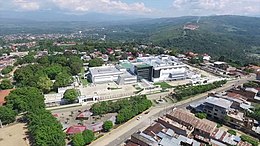This article needs additional citations for verification. (December 2008) |
Tarapoto | |
|---|---|
Town | |
A collage of some places in Tarapoto | |
| Nickname: City of Palms | |
| Coordinates: 6°29′S 76°22′W / 6.483°S 76.367°W | |
| Country | |
| Region | San Martín |
| Province | San Martín |
| District | Tarapoto |
| Founded | 20 August 1782 |
| Government | |
| • Mayor | Henry Maldonado Flores (2019-2022) |
| Area | |
• Total | 60.8 km2 (23.5 sq mi) |
| Elevation | 356 m (1,168 ft) |
| Population (2020)[1] | |
• Total | 183,471 |
• Estimate () | 223,186 |
| • Density | 3,000/km2 (7,800/sq mi) |
| Demonyms | Tarapotino (a) |
Tarapoto is a commercial hub town in the San Martín Province of the Department of San Martín of northern Peru.[2] It is an hour by plane from Lima, in the high jungle plateau to the east of what is known as the selva baja (low jungle). Although Moyobamba is the capital of the region, Tarapoto is the region's largest city and is linked to the Upper Amazon and the historic city of Yurimaguas by a relatively well-maintained transandean highway, paved in 2008–9.[3]
Tarapoto is approximately 356 metres (1,168 ft) above sea level on the high jungle plateau, also called the cloud forest.[4] It was founded in 1782 by Baltasar Jaime Martínez Compañón.[5] According to the 2017 census Tarapoto has a population of 180,073 within the city limits, and over 200,000 inhabitants including the outlying Morales and Banda de Shilcayo districts, which makes it the most populated city in the department and the third largest and most populated Amazonian city after Pucallpa and Iquitos, Tarapoto is older than these cities, in addition to having better services, paved roads, luxury hotels and comforts in the heart of the Amazon.
Tarapoto is often used by tourists and local visitors as a base for excursions into the vast Amazon Rainforest. The region's main activities are tourism, commerce, agriculture, and an illicit "shadow economy" that includes production of coca leaves, lately in decline, extraction of lumber, and trading in land concessions.
Tarapoto is home to the Universidad Nacional de San Martín, an important center of higher education serving the professional and technical needs of a region of high biodiversity.[6] With its active nightlife, Tarapoto offers a wide variety of hotels and restaurants in and around the city. Moreover, the area's beautiful landscapes, waterfalls and lagoons form a tempting location for adventure tourism, such as river rafting and hiking in the tropical Andes, and attract numerous visitors to the "City of Palms".
The City of Palm Trees, concentrates a large part of the tourist and commercial activity in the region, being the third most sought after and visited city by Peruvians, after Lima and Cusco; It is surrounded to the north by the regional conservation area of the Cordillera Escalera within the South American tropical rainforest and to the south by a fertile valley with crops of rice, corn, coffee, cocoa, tobacco and various agricultural products, with seasonally dry forests.
The city is a nerve center of agricultural products, the surroundings concentrate a wide endemic biodiversity, originating from the last foothills of the eastern Andes, these give rise to an enormous botanical and biological wealth, of an incredible variety of amphibian and bird species. ideal for birdwatching, in addition to a large number of waterfalls, this gave rise to the growth of ecotourism, mainly since the mid-1990s.
Currently, the Amazonian metropolis has several hypermarket chains, with all kinds of services, multiplexes, first-class hospitals, high-speed internet, hotel services, luxury resorts, hotels of all categories; The land connection in the mid-1960s brought with it enormous economic and demographic growth to the city, as a result of the construction and paving of access roads, from the capital city, Lima, connecting to the central highway in the central highlands and /or with the Fernando Belaunde Terry highway through Pasco and Huanuco; and in the north interconnected to the cities of Bagua, Chachapoyas, Chiclayo, Piura and Trujillo, and with proximity to the largest port in northern Peru, the port of Paita on the Pacific Ocean and the port of Salaverry in La Libertad, in addition to a connection to Brazil through the river port of Yurimaguas, just 3 hours away by road, and its exit to the Atlantic through the Huallaga River, a tributary of the Marañón River and this of the Amazon River.
- ^ Perú: Población estimada al 30 de junio y tasa de crecimiento de las ciudades capitales, por departamento, 2011 y 2015. Perú: Estimaciones y proyecciones de población total por sexo de las principales ciudades, 2012-2015 (Report). Instituto Nacional de Estadística e Informática. March 2012. Retrieved 4 June 2015.
- ^ Trade Promotion Series. U.S. Government Printing Office. 1925. p. 518.
- ^ "Tarapoto Peru in San Martin - Tarapoto.com San Martín Perú". www.tarapoto.com.
- ^ "Ubicacion de la Ciudad de Tarapoto Peru". www.tarapoto.com. (in Spanish)
- ^ Vergara, Alexis Rolando Arévalo; Meza, Manuel Antonio Reátegui (2019-01-16). Revista de la Academia Sanmartinense de Heráldica y Genealogía N° 1: Los vecinos fundadores de Tarapoto (1782-1802)/Descendencia del Tnte. Crnl. Damián Nájar, Prócer de la Independencia y Gobernandor de Maynas (in Spanish). Yopublico. ISBN 978-87-404-6595-2.
- ^ "Info at fudes-unsm.org".








